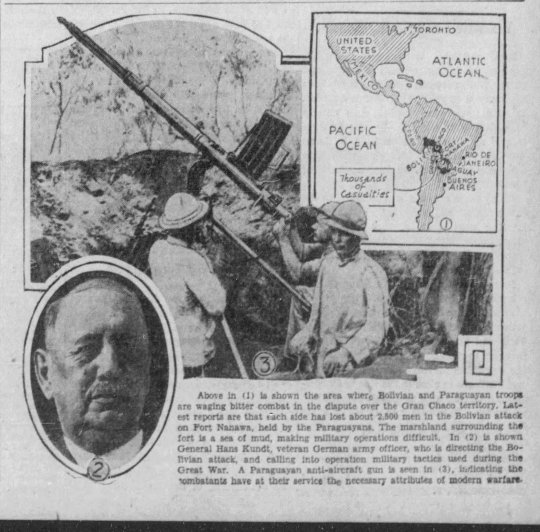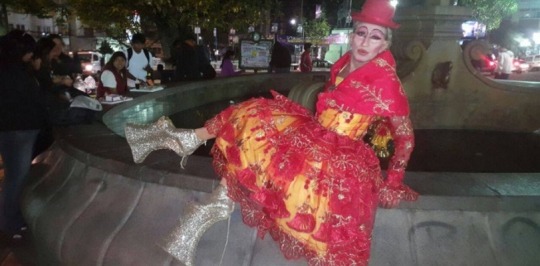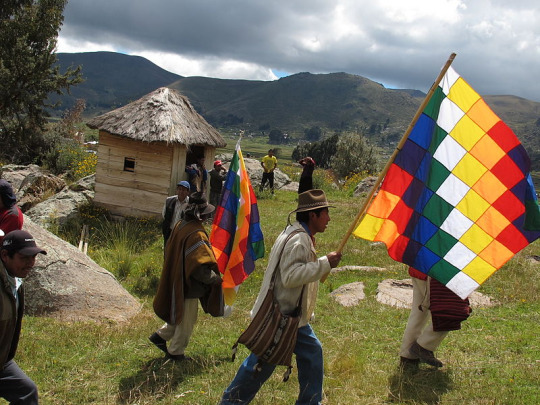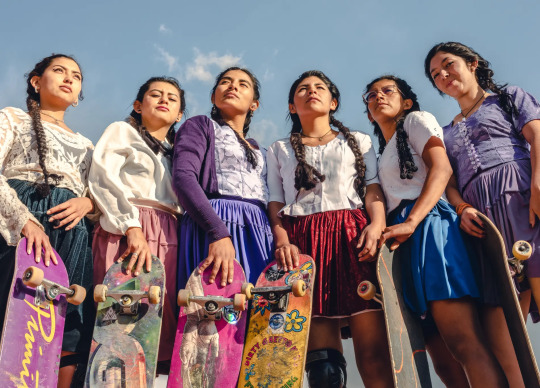#bolivian history
Photo

“Above in (1) to shown the area where Bolivian and Paraguayan troops are waging bitter combat in the dispute over the Gran Chaco territory. Latest reports are that each side has lost about 2,000 men in the Bolivian attack on Fort Nanawa, held by the Paraguayans. The marshland surrounding the fort is a sea of mud making military operations difficult. In (2) is shown General Hans Kundt, veteran German army officer, who is directing the Bolivian attack and calling into operation military tactics used during the Great War. A Paraguayan anti-aircraft gun is seen in (1) indicating the combatants have at their service the necessary attributes of modern warfare.”
- from the Kingston Whig-Standard. January 30, 1933. Page 3.
#gran chaco#chaco war#guerra del chaco#paraguay#bolivia#paraguayan history#bolivian history#fort nanawa#german military advisor#world war 1#interwar period#ejército paraguayo#antiaircraft guns#aa guns#cháko Ñorairõ
4 notes
·
View notes
Photo

Day 20: Vicenta Juaristi Eguino!
Vicenta Juaristi Eguino was born to a wealthy family in La Paz, in modern-day Bolivia. After her mother’s death, her brother stepped into a parental role. Vicenta was well-educated, and she would grow up to share his political ideals. She married, was widowed young, married again, and found herself in control of a personal fortune and property across Bolivia; her life seemed comfortable and secure.
But Bolivia, or, rather, the colony of Charcas, was far from either. The Spanish government taxed the people heavily, while putting restrictions on trade. Outbreaks against the government in 1809 became a decade-long guerilla war, as Spanish colonies up and down South America revolted.
Vicenta joined the revolution. Her mansion was a refuge and meeting-place, where she and other leaders met and planned. The authorities caught wind of her, but Vicenta was undaunted. When she was sentenced to death, the people of La Paz protested so greatly that her sentence was commuted rather than make her a martyr; she was banished to Peru instead.
But Vicenta made a triumphant return. In 1824, she presented the victorious Simón Bolívar (namesake of Bolivia) with the ceremonial key to La Paz. Today, a square in the city bears her name, and she is regarded as one of the three great heroines of the war of independence.
4 notes
·
View notes
Text
ÚRSULA GOYZUETA // HEROINE
“She was a Bolivian heroine. Together with Vicenta Juaristi Eguino and Simona Manzaneda, she is counted as one of the three heroines of the Bolivian War of Independence. She was noted for her role in the defense of Santa Barbara when La Paz was conquered on 22 September 1814. She was captured on 21 November 1816 and sentenced by court martial to a fine of four thousand pesos and being obliged to walk naked tied to a donkey.”
0 notes
Note
Argentina fans on twitter are being racist to Saudis calling them slaves, calling Brazilians monkeys, disrespecting Mexicans, etc. like... misinformation? your country has always been known for being racist and proud of it 🥴
oh yeah im not letting this one pass. guess what? there are horrid bigots everywhere (check the USA) and sadly argentina is no exception yet you can't grab an entire country and call them racist, would you like us to do the same to you? want to talk about operation paperclip? plan condor?
#check your own damn history before coming for us#and yes i know about these bigots because ive been a victim myself my whole life#ive been bullied for having a bolivian mother#so yes i dont need you trying to educate me#nonsims#FUCK those argentinians of course i mean?????? they should choke#damn i hope they do#but dont drag everyone into that and let south america enjoy a win
35 notes
·
View notes
Text
Discover Bolivia: Your Ultimate Travel Guide
A Glimpse into Bolivia’s Rich History
Bolivia, a landlocked country in South America, boasts a diverse and rich history. It was originally inhabited by ancient civilizations, including the Tiwanaku and the Inca Empire. Spanish conquistadors arrived in the 16th century, leading to centuries of colonial rule. Bolivia gained independence in 1825 but has since experienced a turbulent political…

View On WordPress
#a landlocked country in South America#adventure#africa#and activities#and local markets. Adventure Sports: Mountain biking on the infamous Death Road. Wildlife Watching: Spot exotic animals in the Amazon Basin.#and quinoa. Popular dishes include salteñas (empanadas)#and respect local customs. Accommodation Affordability Bolivia offers a range of accommodation options#and sopa de maní (peanut soup). Cultural events and festivals#and sopa de maní for a taste of traditional Bolivian cuisine. 7. Can I use credit cards in Bolivia? Credit cards are widely accepted in majo#and taxis or ride-sharing services are available in cities. Religion Catholicism is the predominant religion#anticuchos#anticuchos (grilled meat skewers)#are also widely spoken. Embark on your Bolivian adventure with this comprehensive guide and immerse yourself in the rich history#be cautious with your belongings#boasts a diverse and rich history. It was originally inhabited by ancient civilizations#but exercise usual precautions. Avoid walking alone at night#but Indigenous beliefs and practices are also widely observed#but it&039;s advisable to carry cash#but it&039;s best to check specific requirements beforehand. 2. What is the best time to visit Bolivia? The dry season from May to October#but many Indigenous languages#but requirements vary by nationality. US citizens#but take usual precautions against petty crime. Avoid demonstrations#carry cash for remote regions and small transactions. Top Places to Visit 1. Salar de Uyuni The world&039;s largest salt flat offers stunni#challenges like rural access and educational quality persist. Universities in major cities offer higher education opportunities. Visa and En#colonial cities#corn#creating a unique cultural blend. Food and Culture Bolivian cuisine is diverse#destinations#Discover Bolivia: Your Ultimate Travel Guide A Glimpse into Bolivia&039;s Rich History Bolivia#especially during the rainy season when it reflects the sky. 2. La Paz The administrative capital
0 notes
Text
Kaoma - Lambada
1989
"Lambada", also known as "Chorando Se Foi (Lambada)" or "Llorando Se Fue (Lambada)" (both meaning 'crying, he/she went away' in Portuguese and Spanish, respectively), is a song by French-Brazilian pop group Kaoma. It featured guest vocals by Brazilian vocalist Loalwa Braz, and was released as the first single from Kaoma's 1989 debut album, Worldbeat.
The song in Portuguese was a mix cover of the 1986 hit "Chorando Se Foi" by Márcia Ferreira (with lyrics translated to Portuguese) and the Cuarteto Continental hit "Llorando Se Fue" (the first upbeat version of the song introducing the accordion), released in 1984; both songs were adapted from the 1981 Bolivian song "Llorando se fue" by Los Kjarkas.
At the time of release, "Lambada" was regarded as the most successful European single in the history of CBS Records, with sales of 1.8 million copies in France and more than four million across Europe. "Lambada" became a worldwide summer hit and was part of the Lambada dance craze. It reached #1 in several European countries, as well as #4 on both the UK Singles Chart and Irish Singles Chart, #5 on the Australia ARIA Singles Chart, and #46 on the US Billboard Hot 100.
However, the Kaoma group did not credit the original song of Los Kjarkas, leading to successful plagiarism lawsuits by the original authors of the song, the Bolivian group and their Portuguese-language co-authors.
"Lambada" recieved a total of 78,5% yes votes!
youtube
2K notes
·
View notes
Text
mutual 1: dissertation on common misconceptions about the history of polish seamstresses in the 1820's.
mutual 2: [second half of a two part post]
mutual 3: [liveblogging the disassembly of some kind of contraption]
mutual 4: lmao one of my chickens laid an egg over eight feet up in a tree
mutual 1: [cock and balls image]
mutual 5: I think, if a girl turned me into some kind of cocksleeve, that would fix me
mutual 3: [continued liveblogging of said disassembly]
mutual 6: gif of lesbians from some arrowverse show you've never heard of
mutual 7: [deep fried meme about some kind of bolivian military hardware]
mutual 8: [mental health advice and soup recipes]
mutuals 1, 2, and 5: elaborate role play of a jury sentencing someone to horny jail
mutual 1: [cock and balls image]
mutual 3: [continued liveblogging]
511 notes
·
View notes
Note
I had a random gut feeling that if writer and actor strikes in USA continues, capitalists may start using their pundits to incite fascists to go after the protesters. Your opinion on this perspective?
We don't know about that Anon, that seems a bit far-fetched. It's not like fascists have a 100+ year history of attacking strikers and trade unions. Unless of course you count Benito Mussolini hiring out his blackshirts as strikebreakers in 1919. Or the fascist attacks & disruptions of the 1926 general strike in the UK. Or Hitler making trade unions illegal in 1933 and then sending trade unionists to be murdered in concentration camps.
Anyways, that's all ancient history and there are no examples of recent fascist activity targeting trade unions. Aside from the fascist attack on striking railway workers in Manchester in 2019. Or the murder of Bolivian miner union leader Orlando Gutiérrez in 2020 by a mob of fascists protesting the outcome of the country's election by beating him to death. Or the 2021 attack on the headquarters of an Australian construction workers' union in Australia in 2021 by far-right extremists and anti-public health conspiracy theorists, who broke into the building and attacked union officials and union staff. Or the attack by members of the fascist Forza Nuova party on a union office in Rome, Italy that same year. Or the (failed) attempt by fascists in Albi, France to assault trade union members (only to be badly beaten themselves by the union members!) in October 2021. Or the November 2021 attack on two union members in Paris by a fascist gang.
Well anyways it's not like fascist leaders like the UK's Alek Yerbury are currently calling for his followers to target union offices, picket lines, and strikers.
You see? Nothing at all to worry about and anti-fascists shouldn't bother showing their support and solidarity with working people striking in an attempt to raise the working conditions and lives of all of us! OR MAYBE WE SHOULD???
707 notes
·
View notes
Text

HAPPY VALENTINES DAY !!
You already know I had to do something for these two dingbats (affectionate). Anyways, a friend of mine suggested a plane museum date and I couldn't not do it.
Nerd stuff below the cut --
So fun fact- the background was inspired by my personal favourite aviation museum, the Museum of Flight in Seattle, Washington, USA. In their WWII section, there are two planes facing each other: a Yakovlev-9U (Soviet) and a Republic P-47-D (American). Me, being the brain-rotted plane nerd I am, I wanted to draw something AmeRus related for Valentine's Day as an excuse to draw some planes.
The markings of the planes in the drawing aren't exact to the two planes you can see IRL, but the inspiration for the depicted versions are the restored Yak-9U Construction Number 0815346 and P-47 Serial Number 42-8205.
The Yak-9U is painted in the markings of Russian WWII ace, Gen Maesky, however this specific plane was restored in 1992 with no service history available prior to that. Restoration was completed in 1994, and the project used the original engine and propeller with the rest of the parts likely sourced from the Yak-9P or other miscellaneous manufacturing.
The P-47 has more documentation regarding its history since it was in active use up to the 70's and in the hands of a collector/restoration team after that. It was constructed in 1942 as a P-47D-2-RE and used by the USAAF under the SN 42-8205. Sometime around 1949, this plane was provided to the Bolivian Air Force under SN 007. It remained in service with the Fuerza Aerea Boliviana until 1976 when it was brought back to the US to be restored. In 1991, the "Big Stud 88" markings were applied, and it was finished in the marking style of Colonel Robert Baselers of the 325th Fighter Group, who were famous for their checkered tail paint scheme.
This is not the original Big Stud as flown by Col. Robert Baseler, it was just decorated with it's markings.
Anyways, here is a pic taken by yours truly of the IRL planes !!

#wanchii draws#hetalia#aph hetalia#hetalia fanart#aph#hws#aph america#aph russia#hws russia#hws america#amerus#rusame#hetalia amerus#hetalia rusame#alfred f jones#vanya braginsky#hetalia valentines day#thanks for listening to me yap about planes
71 notes
·
View notes
Text

París Galán (Carlos Heredia)
Gender: Non binary (any pronouns)
Sexuality: Gay
DOB: 5 February 1968
Ethnicity: White, indigenous Bolivian (Quechua)
Occupation: Drag artist, activist, politician (Sovereignty and Liberty)
Note: He made history as the first-ever openly transgender individual to win elective office in Bolivia after being elected to the La Paz Departmental Legislative Assembly in 2015
#París Galán#Paris Galan#Carlos Heredia#lgbt#lgbtq#non binary#gay#1968#bolivian#native#indigenous#biracial#hispanic#drag artist#politician#activist#first
99 notes
·
View notes
Text
the history of immigration in buenos aires is so goddamn interesting the early 20th century must've been such a strange moment to live in this city. over 50% of the population was immigrant, and from all over. and they both took from the local culture and added to it. my grandma (armenian but born here in the 30s) developed a taste for tango from her neighbours who were second generation english (older immigration). my dad grew up in the 60s with a galician-uruguayan mother and a canarian grandpa, next to a huge italian family and an armenian family who raised goats, and spent his childhood playing on the streets with the children of spaniards, italians, poles, irishmen. in the last thirty or so years my neighbourhood has become mostly a bolivian and peruvian neighbourhood but nowadays there's a lot of venezuelans and colombians, some senegalese people. you keep hearing people speak russian and ukranian on the streets. now. anyways, fascinating.
#sorry i was reading about the biritsh cemetery which we apparently have#turns out when they made the chacarita cemetery in 1870#(because of the yellow fever crises; burying people so close to the city centre became dangerous and also A LOT of people died)#the municipal government gave a couple blocks to the protestants there (british german and yanquis) so they could bury their dead there too#and then in 1915 after wwi started the british and the germans decided to separate their cemeteries#but i assume you're likely to find some really old british tombs on the german side and viceversa#theyre small cemeteries cause those are fairly small communities. the armenian and the jewish cemeteries on the other hand had to expand#anyways. cool history!!! i wanna read that whole series they got out about different immigrant communities in the city#there's like 30 of them I'm not interested in ALL but#argentina
23 notes
·
View notes
Text
GREGORIA APAZA // REBEL
“She was an indigenous leader in Bolivia. In 1781, she participated with her brother Julian Apaza (Tupac Katari) and sister-in-law Bartolina Sisa in a major indigenous revolt against Spanish colonial rule in Bolivia. These Aymara leaders laid siege to the cities of La Paz and Sorata before being defeated and executed.”

1 note
·
View note
Photo

On this day, 15 November 2011, in Trinidad, Bolivia, a group of disabled Bolivians began a march to capital La Paz. The march was to encourage the government to increase support for disabled people and to tackle societal stigma about disability. The march grew to 200 including children, with 1,000 supporters in La Paz. When the march entered La Paz in February 2012 they were met with riot police who attacked the march. In the aftermath an embarrassed president Evo Morales conceded several of their demands. An account of the march can be found here: http://libcom.org/history/2011-12-disabled-bolivians-march-la-paz https://www.facebook.com/workingclasshistory/photos/a.296224173896073/2135995356585603/?type=3
224 notes
·
View notes
Text
Crucifixion art by Quechua Bolivian artist
An image of the Crucifixion by Indigenous (Quechua) Bolivian artist Severino Blanco.

+++
My friend Emily VIctoria Jones wrote this in her 2020 blog post at https://artandtheology.org/2020/01/31/my-eyes-have-seen-artful-devotion/ -
Severino Blanco is a Quechuan Christian artist from Cochabamba, Bolivia. In the early 1980s he was commissioned by Father Manfred Rauh (1932–2011), a Jesuit missionary from Germany who spent most of his priestly life in Bolivia, to create a Life of Christ painting cycle for the interior of the chapel of the Casa del Catequista (CADECA), a training center for catechists. To make the gospel story really come alive for the catechists, who are mostly Quechua and Aymara, Blanco chose to set it in an Andean context, with Jesus as an indigenous South American—fully human, fully immersed in history and culture, fully for them. The images are reproduced, with commentary, in the German-language book Von Befreiung und Erlösung: Bilder in CADECA Cochabamba/Bolivien (Of Liberation and Redemption: Pictures in CADECA Cochabamba, Bolivia). A few can also be viewed online here, here, and here. The chapel was consecrated in 1984 and is still in use.
4 notes
·
View notes
Text

Indigenous peoples in Bolivia
Indigenous peoples in Bolivia, or Native Bolivians, are Bolivian people who are of indigenous ancestry. They constitute anywhere from 40 to 70% of Bolivia's population of 11,306,341, depending on different estimates, and belong to 36 recognized ethnic groups. Aymara and Quechua are the largest groups.
Languages spoken: Spanish Language, Paraguayan Guaraní, Aymara language
Geographic distribution: Bolivia

Aymara ceremony in Copacabana, on the border of Lake Titicaca in Bolivia.

Created by two friends in 2019, the female collective ImillaSkate wear the traditional Bolivia polleras dress associated with the indigenous women of the highland regions as a symbol of resistance

Indigenous Peoples in Bolivia Walk Over 300 Miles to Demand Respect for their Lands and Cultures
In 1991, the Bolivian government signed the Indigenous and Tribal Peoples Convention, 1989, a major binding international convention protecting indigenous rights. On 7 November 2007, the government passed Law No. 3760 which approved of UN Declaration on the Rights of Indigenous Peoples.
In 1993, the Law of Constitutional Reform recognized Indigenous Rights
In 2015 Bolivians made history again by selecting the first Indigenous President of the Supreme Court of Justice, Justice Pastor Cristina Mamani.
Indigenous peoples in Bolivia - Wikipedia
8 notes
·
View notes
Text










nothing more beautiful than Bolivian history…
3 notes
·
View notes